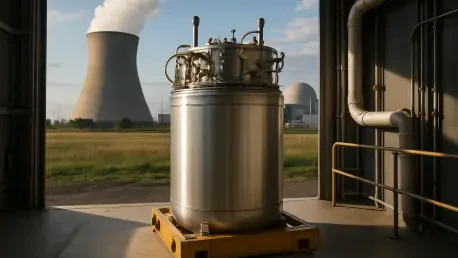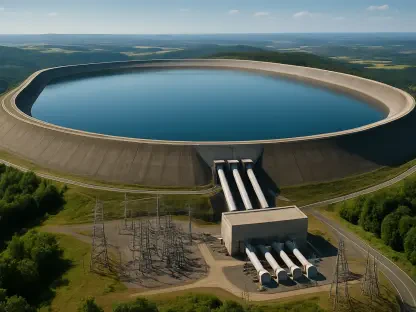The Nuclear Regulatory Commission (NRC) has undertaken a significant policy shift concerning microreactors, reflecting the growing interest and technological advancements in smaller-scale nuclear solutions. These microreactors, distinct from their large-scale counterparts, offer advantages like portability and adaptability, positioning them as pivotal players in decentralized energy systems. This modernization in the regulatory approach supports ongoing innovation and aligns with current energy trends. The decision to relax the stringent regulations—typically associated with larger reactors—acknowledges the unique safety profiles and potential applications of microreactors, recognizing their role in diversifying energy strategies and addressing niche energy demands efficiently.
Microreactors, as characterized by the U.S. Department of Energy (DOE), are compact nuclear units typically generating 20 megawatts (MW) or less of thermal power. These reactors stand out for their enhanced portability, enduring fuel life cycles, and their ability to integrate seamlessly into microgrids. Their promising applications extend beyond conventional electricity generation to include hydrogen production, water desalination, and district heating. This diverse potential supports a wide array of sustainable energy solutions, particularly in regions requiring resilient, localized power sources. The NRC’s regulation overhaul is a timely response to these capabilities, encouraging further exploration and deployment within these fields.
Encouraging Microreactor Innovation
The NRC’s updated approach facilitates the fueling of factory-assembled microreactors without imposing the rigorous requirements that govern traditional nuclear reactors as they commence operation. By revising the criterion that previously dictated when a reactor is considered operational, the new guidelines reflect a progressive stance in the regulatory landscape. A pivotal element in this regulatory acclimation is recognizing the innate safety measures that prevent criticality—defined as the onset of a self-sustaining nuclear fission chain reaction—in microreactors. This strategic pivot aligns with international trends, notably in regions like Finland, where microreactors are being evaluated for district heating purposes, illuminating the global applicability of this innovative nuclear technology.
Furthermore, the endorsement of a separate measure permitting the operational testing of commercial microreactors under conditions historically reserved for research and test reactors underscores the NRC’s commitment to fostering technological advancements. This flexibility within regulatory frameworks is expected to accelerate the development and implementation of microreactor systems, catalyzing their evolution into viable commercial entities. The revision signifies a readiness to embrace the shifting nuclear technology landscape by tailoring regulations to accommodate the unique characteristics of microreactors. This change recognizes their potential contributions to a sustainable energy future and positions the United States as a leader in deploying emerging nuclear technologies.
Military and Commercial Applications
While microreactors have not yet gained a substantial foothold in civilian market applications, they hold a history of reliable use in military contexts, particularly powering naval vessels and submarines. This proven effectiveness in military infrastructure underscores the reactors’ capacity for operational stability and efficiency. The U.S. Department of Defense (DOD), through initiatives like Project Pele, aims to integrate operational microreactors into strategic defense frameworks, potentially activating the first such reactor at Idaho National Laboratory as early as next year. These efforts illustrate the strategic synergy between energy independence and national security, emphasizing the reactors’ dual utility in both military and commercial sectors for sustainable power solutions.
Historically, cementing a nuclear reactor’s operational status involved a protracted licensing pathway, primarily dictated by its initial fueling. This extensive licensing process could span several years, constraining the timely deployment of nuclear solutions. In contrast, the redefined policy differentiates microreactors by associating operational status with the removal of safety features preventing criticality. This adjustment accommodates logistical nuances associated with microreactor deployment, which often involves factory production and subsequent transportation to operational sites. By acknowledging these practicalities, the NRC policy embraces the evolving nature of nuclear technology, offering a pathway for agile deployment and fostering innovation in the nuclear sector.
Advancing Regulatory Frameworks
In response to these developments, NRC commissioners have directed staff to design a comprehensive regulatory framework specifically tailored for microreactors. This initiative encompasses the multiple facets of microreactor technology, including manufacturing, operational testing, fuel loading, and transportation. By providing a regulatory outline equipped to manage the unique technical challenges, the NRC aims to ensure microreactor operations adhere to the highest safety standards, particularly regarding criticality prevention. This proactive stance supports an environment where microreactors can flourish safely and effectively, further integrating into diverse energy systems.
Christopher Hanson’s insights, shared prior to his departure from the NRC, accentuated the criticality of ensuring safe transit at the end of a microreactor’s productive cycle, especially when dealing with irradiated fuel. Hanson underscored the dual challenges faced during microreactor deployment and decommissioning phases, advocating for a comprehensive regulatory focus spanning a reactor’s full lifecycle. This long-term outlook not only reinforces safety protocols but also champions sustainable management practices pivotal to responsible nuclear technology deployment. The NRC’s focus on these end-of-life stages speaks to a broader commitment to fostering innovation while upholding rigorous safety standards.
Implications for Future Energy Strategy
The Nuclear Regulatory Commission (NRC) has initiated a notable shift in policy concerning microreactors, which highlights the increasing interest and advancements in smaller nuclear technologies. Unlike their larger counterparts, these microreactors are esteemed for their portability and adaptability, making them critical in decentralized energy systems. By modernizing its regulatory framework, the NRC is supporting ongoing innovation and aligning with emerging energy trends. The ease in regulatory requirements, traditionally applied to large reactors, acknowledges the distinct safety characteristics and versatile applications of microreactors, recognizing their ability to expand energy strategies and meet specific energy needs effectively.
According to the U.S. Department of Energy (DOE), microreactors are small nuclear units that generate up to 20 megawatts (MW) of thermal power. They are notable for their portability, long-lasting fuel life, and seamless integration into microgrids. Their applications go beyond generating electricity and can include hydrogen production, water desalination, and district heating. The NRC’s updated regulations are a timely acknowledgment of these possibilities, encouraging further research and practical applications.









